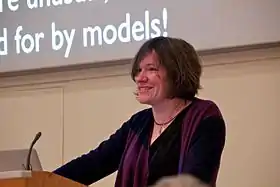
Julianne Dalcanton (born 1968) is an American astronomer, professor of astronomy, researcher and comet discoverer.[1] Since September 2021 she is the director of the Simons Foundation Center for Computational Astrophysics.[2]
Career
Julianne Dalcanton joined the Simons Foundation in September 2021 as Director of the Flatiron Institute’s Center for Computational Astrophysics (CCA) in New York City.[3] Prior to this she was Professor of Astronomy, University of Washington, Chair of the Astronomy Department, and researcher for Sloan Digital Sky Survey. Her main work is on the area of galaxy formation and evolution. She led the ACS Nearby Galaxy Survey Treasury (ANGST) and is leading the Panchromatic Hubble Andromeda Treasury (PHAT) programs on the Hubble Space Telescope.[4] She became known worldwide by her discovery of the comet C/1999 F2 Dalcanton. She is also a contributor to the physics blog Cosmic Variance.
Awards and honors
In 2018, Professor Dalcanton was awarded the Beatrice M. Tinsley Prize by the American Astronomical Society in recognition of her work in Astronomy and "contributions that are of an exceptionally creative or innovative character and that have played a seminal role in furthering our understanding of the universe."[5][6] Asteroid 148384 Dalcanton, discovered by the Sloan Digital Sky Survey in 2000, was named in her honor.[1] The official naming citation was published by the Minor Planet Center on 6 April 2012 (M.P.C. 79106).[7]
Journal articles
- Dalcanton, Julianne J.; Spergel, David N.; Summers, F. J. (1997). "The Formation of Disk Galaxies". The Astrophysical Journal. 482 (2): 659–676. arXiv:astro-ph/9611226. Bibcode:1997ApJ...482..659D. doi:10.1086/304182.
- Hogan, Craig J.; Dalcanton, Julianne J. (2000). "New dark matter physics: Clues from halo structure". Physical Review D. 62 (6): 063511. arXiv:astro-ph/0002330. Bibcode:2000PhRvD..62f3511H. doi:10.1103/PhysRevD.62.063511.
References
- 1 2 "148384 Dalcanton (2000 SV373)". Minor Planet Center. Retrieved 15 August 2019.
- ↑ "Julianne Dalcanton Named Next Director of the Center for Computational Astrophysics". Simons Foundation. 2021-07-06. Retrieved 2021-07-18.
- ↑ "Julianne Dalcanton". Simons Foundation. 2021-09-15. Retrieved 2022-03-09.
- ↑ "Triangulum Galaxy Messier 33 (M33)". HubbleSite.
- ↑ "Beatrice M Tinsley Prize". American Astronomical Society. Retrieved 15 August 2019.
- ↑ "Department of Astronomy". Washington University. Retrieved 15 August 2019.
- ↑ "MPC/MPO/MPS Archive". Minor Planet Center. Retrieved 15 August 2019.